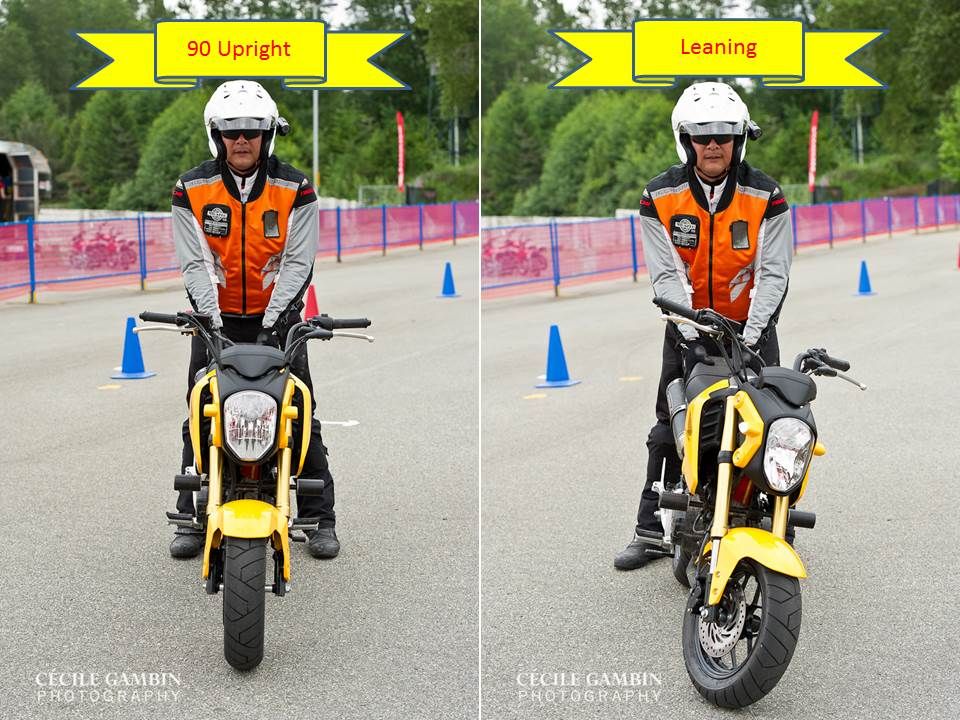Cornering Intro: Push steering (counter steering) is the only way to turn motorcycle?
Canada
Little while ago, I posted “how to operate braking system of motorcycle”.
There are 3 major ways of braking.
1: Braking to stop
2: Braking to slow down
3: Braking to load / compress suspensions to get traction

Self-Steering
I think I will post this “braking” subject time to time…even if it will be exactly same contents. Because it is always good to remember.
Today, I would like to post “cornering”.
But again….step by step basis....without complicated academic-wordings.
First, before you jumping on and say “so, what is the trick to go fast on corners?”…..let me tell you first.
You’ve got to understand 2 things.
a) Cornering in high-speed range (ie: road race circuit track) and slow-speed range (ie: street / high-way) are very different.
b) You must understand basic physics of motorcycle (2 wheels vehicles)
On road-race circuit track, almost all racers apply “push-steer / counter-steer” technique when cornering. The lean angle is very deep and sharp, and bikes move very quick in amazing fast speed range…ok, this is the one you must realize very first….let me ask you question...."Why those motorcycles need to lean?"
The answer is very simple and sounds silly…because they need to lean in order to turn corners....Ok, then…let me rephrase the question. What helps to make those motorcycles to turn?
The answers are….racing compound tyres AND Centrifugal Force….yes, Centrifugal Force…maybe some of you tried swinging 360 rotation the water filled bucket when you were a child….the water didn’t spill as long as you kept it swinged…correct?
The bike (a water filled bucket) leans in high-speed….that means the lean angle is getting closer to ground surface…then, this Centrifugal Force occurs and pulls the bike to outside…bike is not totally level but keeping certain lean angle (in this case, also closer to 90 degrees upright…keeping the balancing point.) it has some resistance / friction on tyres to stop sliding out....like water remains in the bucket when swinging.... (let’s ignore the condition of tyres and road surface) Then bike turns….does this make sense to you? This depends on the weight of motorcycle (plus rider) and speed to create Centrifugal Force.
On the other hand…..riding on street (slower speed range), you won’t be able to depend on the Centrifugal Force but steering the handle-bar. Hm….I think some of you say “Ah~ I get it, that is why we do the push-steering! I know now, thanks Yoshi!”…not so fast, mate. You got to read till I finish.
Before I talk about Push-Steering, I need to tell you this physics….
“Push Steering NEVER helps turning but helps motorcycle to lean”
Maybe you will react like “What are you talking about? Of course helps turning!!”
Wait a minute….let me post some pictures…actually, you can do this experiment even using bicycle.
Standing behind the bike and keep it 90 degrees upright, push the bike forward, then slightly lean either right or left…..can you see the handle-bar turns by itself? That is the mechanism of turning. Steering angle is set by lean angle.
Long ago, I often heard my fellow instructor colleagues spoke out in front of students when teaching this push-steering technique….”let’s say, when you are cornering on highway ramp and if you think you cannot make the corner, push the handle-bar more”…I will say…Yes & No…. “Yes” means, if the bike is not leaning deep, then pushing the handle-bar more and leaning more makes sense….IF the bike is leaning deep….there will be NO WAY but one possible technique to recover….I will post this recovery technique later day.
Ok, that is for today….
(to be continued)
PHOTO by Cecile Gambin Photography
Motorcycle supported by Honda Motorcycles & ATVs Canada
You must be logged in to comment
Login now
Another simple way of looking at it from a physics point of view is this;
An imaginary plumb bob hanging from the bike's centre of gravity will always touch the ground at a point on a line drawn between the front and rear tyre contact patches. At the instant it moves away from that line for any reason, the bike is down.
In other words everything we do on a bike is directed at keeping the three points in synch. When the bike turns, it is a result of a change in one of the three, and the resulting compensation.
Another simple way of looking at it from a physics point of view is this;
An imaginary plumb bob hanging from the bike's centre of gravity will always touch the ground at a point on a line drawn between the front and rear tyre contact patches. At the instant it moves away from that line for any reason, the bike is down.
In other words everything we do on a bike is directed at keeping the three points in synch. No matter what the angle.